Michelangelo Merisi known as Caravaggio (Milan, 1571 - Porto Ercole, 1610) is one of the greatest painters in art history. Early in his career he left Milan, his hometown, and moved to Rome, where he worked for Cardinal Francesco Maria del Monte and other important patrons. Because of his easily irritable and violent temperament, he was the protagonist of a series of negative events, including a murder that, from 1606, forced him to leave Rome and to move continually, on the run, first to Naples, then to Malta, then to Sicily and Naples again: from here he left with the hope of returning to Rome, but he fell ill and died on the beach at Porto Ercole.
What was Caravaggio’s greatness and importance within art history? Art historian Vittorio Sgarbi, who has devoted many popular works to the Lombard artist, says in the introduction of his book Il punto di vista del cavallo: Caravaggio (2014, Bompiani editore) that Caravaggio is great "Because one can hardly believe that his ideas were conceived four centuries ago. Everything in his paintings, from the light to the cut of the composition, suggests an art that we recognize, a cast of sensibilities and experiences that are not those of the seventeenth century but those of every century in which man has been present and central; one can call it the painting of reality, and to this it owes its unceasing relevance." Therefore, to be in front of a painting by Caravaggio is to immerse oneself in reality, because the artist intended to reproduce it in a completely mimetic way, as no one before him had ever done.
To some extent, Caravaggio anticipates photography, born in the 19th century but foreshadowed by Michelangelo Merisi as early as the early 17th century, “refusing,” Sgarbi points out, “to represent reality as it should be, as a projection of feelings, of a Good and an Evil understood as symbolic values. Caravaggio observes and reproduces reality exactly as it is, exactly as we see it in a good photograph. More: it is not photography in the sense of posed portraits, it is photography in search of a reality that catches us as if by surprise, of the decisive moment referred to by a great photographer like Henri Cartier-Bresson: photography as waiting for and capturing the moment when reality is being determined.”
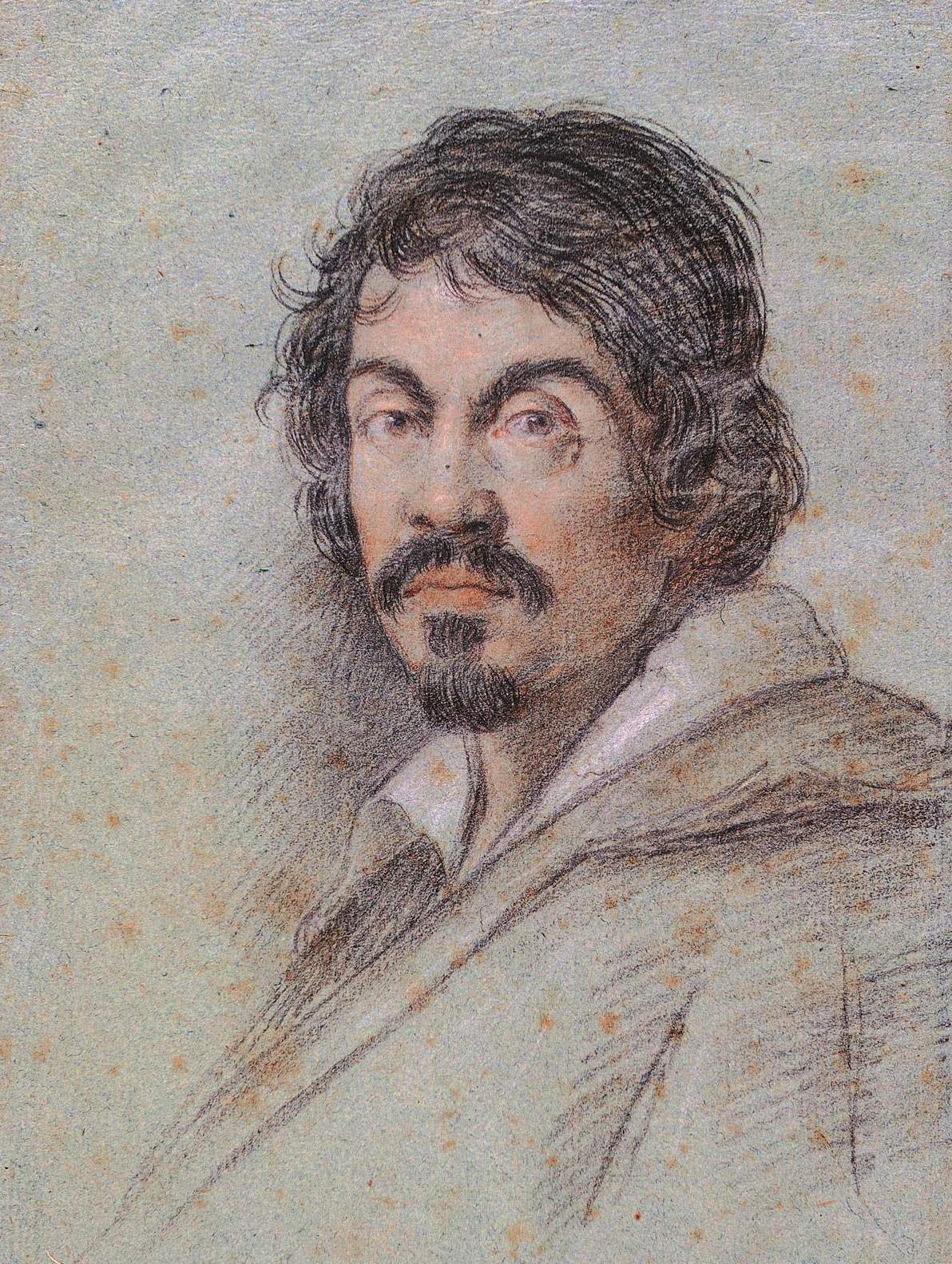 |
| Ottavio Leoni, Portrait of Caravaggio (1615-1620; black charcoal and pastels on blue paper, 234 x 163 mm; Florence, Marucelliana Library) |
Michelangelo Merisi known as Caravaggio was born on September 29, 1571, in Milan (and not in the town of Caravaggio in the Bergamo area as has always been thought), to Fermo Merisi and Lucia Aratori (names that would later inspire the protagonists of Manzoni’s Promessi sposi ). Due to a plague raging in the Lombard city in 1577, the artist and his family moved to the village of Caravaggio where little Michelangelo spent his childhood. His father and uncle, however, fell ill and died shortly thereafter. At thirteen, Michelangelo was sent by his mother to the workshop of Simone Peterzano (Venice, 1535 - Milan, 1599), a mannerist painter and pupil of Titian Vecellio. In Peterzano’s studio he stayed about four years: here he had the opportunity to learn the teachings of Lombard and Venetian painters. Probably in 1592, shortly after the death of his mother, the artist decided to move out of the region. According to Giovan Pietro Bellori, an art historian and biographer of the Italian Baroque , his move was due to a ’murder charge from which he wanted to escape, but we do not know for sure. Although he is thought to have moved to Rome immediately, according to the testimony of barber Pietro Paolo Pellegrino he arrived in the capital years later, in 1597 (so there is a five-year gap in the artist’s biography). According to Bellori’s account, Caravaggio first headed to Venice, where he learned the stylistic influences of Giorgione and Titian, and only later did the move to Rome take place.
In the Roman milieu he met the Sicilian painter Lorenzo Carli, who took him in and hired him at his workshop on Via della Scrofa. Having concluded his association with Carli, he attended for a few months the workshop of Giuseppe Cesari known as Cavalier d’Arpino (Arpino, 1568 - Rome, 1640), one of the major painters of late Mannerism. After being discharged from the Ospedale della Consolazione due to illness, Caravaggio met Cardinal Francesco Maria del Monte in 1597, who became his patron for a few years.
During these years his fame in Rome grew and his painting began to become known among the Roman nobility, creating havoc for his radical innovations but also achieving considerable success. Thanks in part to his collaboration with the cardinal, he abandoned the small format to devote himself to more complex and larger works. In 1599 he was commissioned three paintings concerning episodes from the view of St. Matthew (vocation and martyrdom) to be placed in the Contarelli Chapel of the Church of San Luigi dei Francesi in Rome. These paintings represent for his artistic career the rise to important commissions such as the Nativity with Saints Lawrence and Francis of Assisi
(the painting, made in 1600, destined for Palermo and now lost: read an in-depth discussion of the work here) the Crucifixion of St. Peter (1600-1601), the Conversion of St. Paul (1601), and St. Matthew and the Angel (1602).
Because of his irascible temper, he was denounced several times for brawling and violence, and imprisoned several times between 1600 and 1606. In 1606, in the course of one of these brawls, Caravaggio killed one of his rivals, Ranuccio Tommasini da Terni, during a game of pallacorda, but the motive probably involved economic issues. Caravaggio is sentenced to be beheaded, a very recurrent theme in his future works in which he self-portrays himself as the beheaded man. After the terrible sentence Caravaggio fled to Naples with the help of acquaintances such as Filippo I Colonna. He settled in Naples in 1606 and remained there for about a year. During this period he produced works such as Flagellation of Christ (1607), Salome with the Head of the Baptist (1607), David with the Head of Goliath (1607), Crucifixion of St. Andrew (1607), and Madonna of the Rosary (ca. 1605). In 1607 he moved to Malta hoping to become a knight in order to gain immunity from the sentence of beheading. Here the artist painted the Beheading of St. John the Baptist (1608) andSt.Jerome Writing (1607-1608). Eventually on July 14, 1608, he obtained the office of Knight of Grace. Shortly after his appointment, because of yet another quarrel, he was immediately imprisoned in the prison of Sant’Angelo in Valletta, from which, however, he managed to escape by arriving in Syracuse where he was helped by his friend Mario Minniti (Syracuse, 1577 - 1640), a Sicilian painter whom he had already met during his stay in Rome. In Sicily he continued his artistic production by creating works such as the Seppellimento di santa Lucia(1608), the Resurrezione di Lazzaro (1609) and theAdorazione dei pastori(1609).
In 1609 the artist returned to Naples and painted some masterpieces such as St. John the Baptist Reclining (1610), the Negation of St. Peter (1610), St. John the Baptist (1610), and David with the Head of Goliath (1610) in which he portrays himself in place of Goliath. His last works include the three canvases for the church of Sant’Anna dei Lombardi in Naples lost in 1805. Caravaggio’s last painting appears to be the Martyrdom of St. Ursula (1610). He died at the age of only thirty-eight in Porto d’Ercole following an illness on July 18, 1610.
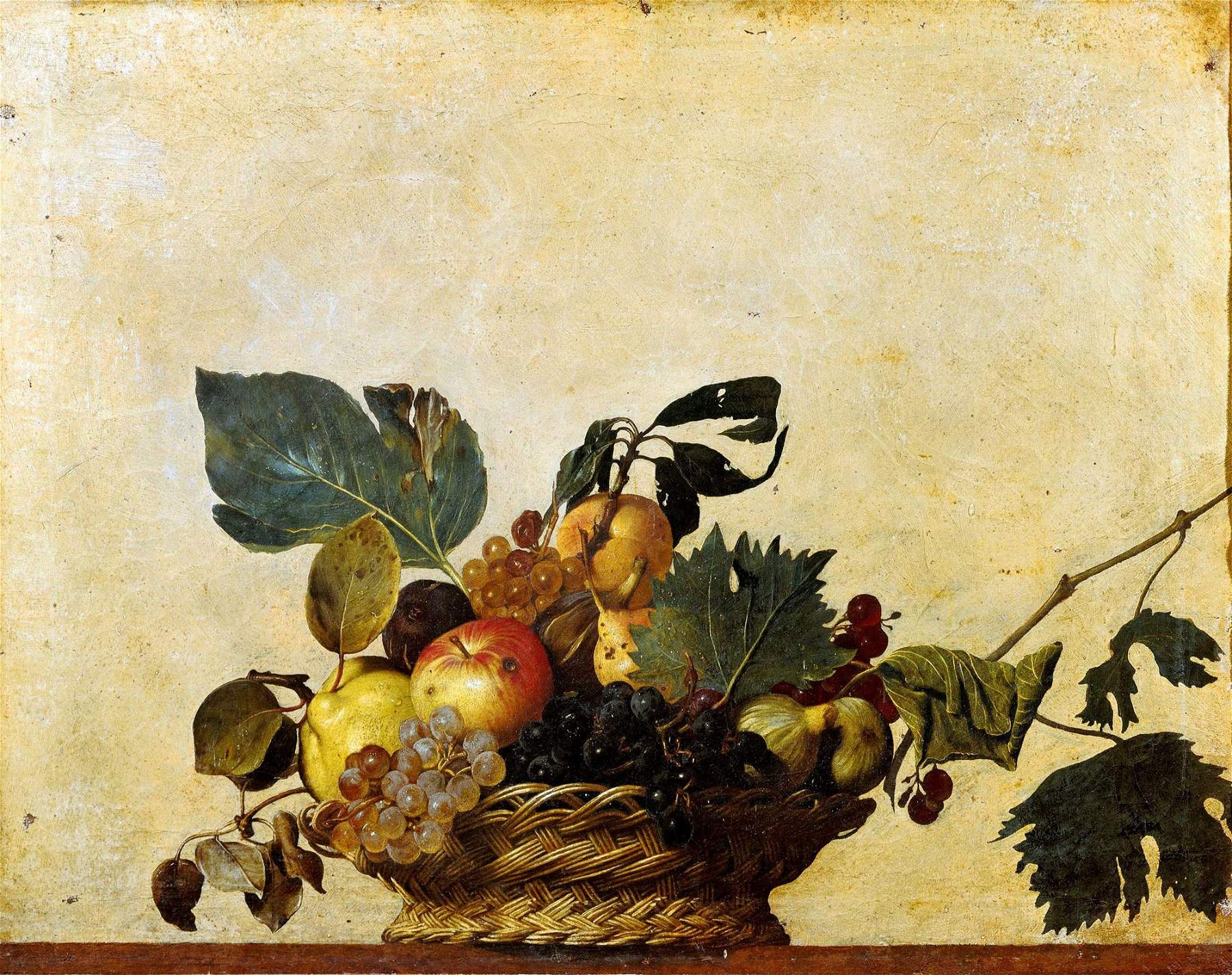 |
| Caravaggio, Basket of Fruit (1594-1598; oil on canvas, 31 x 47 cm; Milan, Pinacoteca Ambrosiana) |
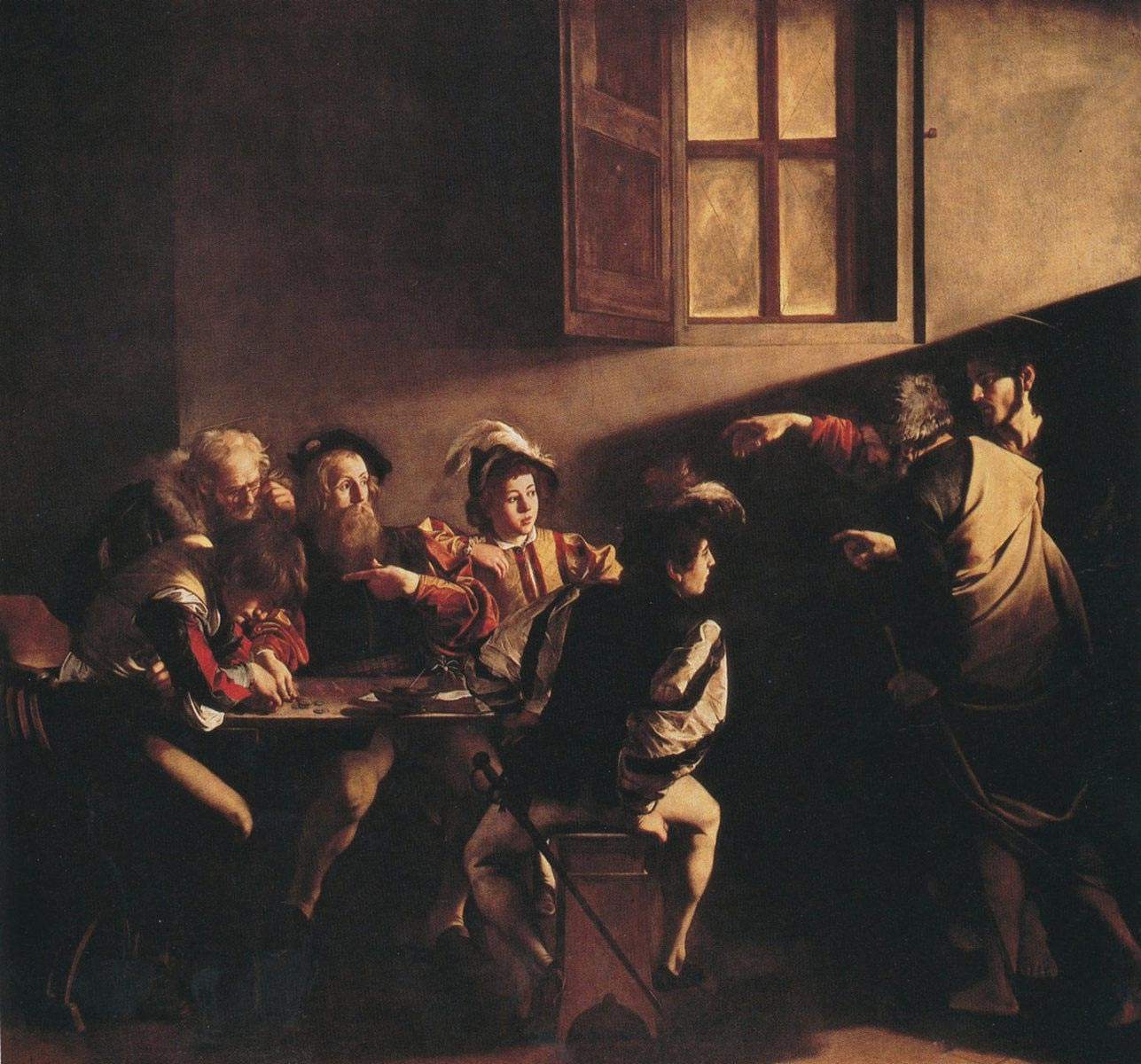 |
| Caravaggio, Vocation of St. Matthew (1599-1610; oil on canvas, 322 x 340 cm; Rome, Church of San Luigi dei Francesi) |
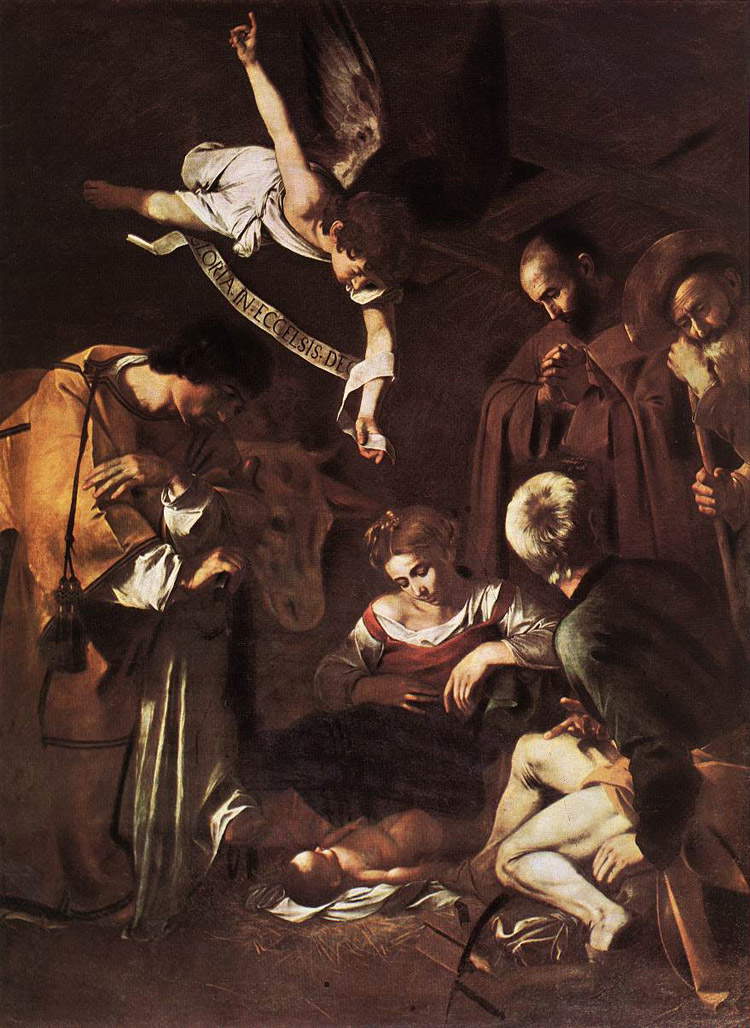 |
| Caravaggio, Nativity with Saints Lawrence and Francis (1600; oil on canvas, 268 x 197 cm; Palermo, formerly in the Oratory of San Lorenzo, stolen in 1969) |
 |
| Caravaggio, Judith and Holofernes (1602; oil on canvas, 145 x 195 cm; Rome, Gallerie Nazionali d’Arte Antica di Roma, Palazzo Barberini; Photo by Mauro Coen) |
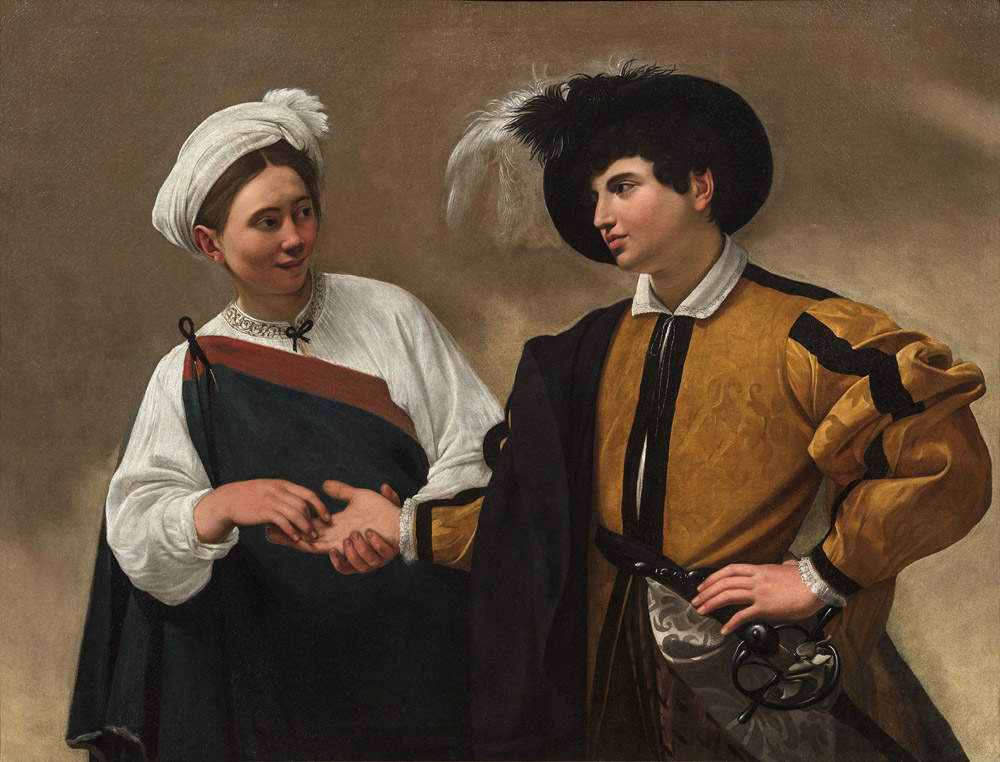 |
| Caravaggio, The Good Fortune (1597; oil on canvas, 115 x 150 cm; Rome, Musei Capitolini - Pinacoteca Capitolina) |
Despite Caravaggio’s profligate life, a trait of his personality that greatly fascinates the public, his painting is among the most innovative in all of art history. While drawing on artists such as Titian or Raphael, Caravaggio constitutes one of the most important representatives of naturalism, a style based on the study and representation of reality. In fact, the Lombard painter depicts authentic scenes, the result of his frequentation of everyday life. The protagonists of his works are almost always humble people, almost never professional models. Thanks to the skillful use of light and shadow, his paintings are charged with an almost theatrical atmosphere that focuses attention only on the subjects. The plasticity of the faces depicted is emphasized by the perfection of his chiaroscuro that highlights the thickness and volume of the figures.
In the early period of his artistic career he painted mainly still life compositions. Among these representations certainly the best known is the Basket of Fruit (1596), which is considered the first still life in the history of Italian art: the only subject of the painting is a basket of fruit. In the light and bright background emerges a basket filled with fruit of various kinds depicted in its veracity (in fact, it has natural imperfections such as leaves eaten by insects or worm-eaten apples). Also during this period the artist painted the Sick Bacchus (1596-1597), probably a self-portrait of himself. It was during these years that the painter was hospitalized for a brief illness, and the painting would appear to have been executed during his convalescence. The subject depicted is the ailing Bacchus, who lets his illness shine through his pale, bluish complexion, illustrated in a naturalistic manner.
After befriending Cardinal Francesco Maria del Monte, the artist entered the circle of Rome’s most important patrons and was commissioned to make three paintings illustrating the events of St. Matthew for the Contarelli Chapel located inside the church of San Luigi dei Francesi in Rome. Among the composition, the most important painting is the Vocation of St. Matthew (1599). The canvas shows the precise moment when Christ calls Levi (St. Matthew) to the apostolate. The scene takes place indoors while Levi is sitting at a small table with other people. Because of the ’somber atmosphere Christ’s call is accentuated by the one ray of light, coming from the window in the upper right corner, which illuminates his face, highlighting it. The light thus symbolizes divine Grace and simplifies the reading of the painting. Both Peter and Christ, depicted to the right of the picture, point to Levi himself, who in turn reacts with an incredulous and astonished expression. In Rome he is commissioned for numerous works, one example being the Conversion of St. Paul (1601). The work is commissioned by Monsignor Tiberio Cerasi, who commissions him to paint two canvases depicting the Conversion of St. Paul and the Crucifixion of St. Peter. The painting depicts the moment of St. Paul’s vocation in which he falls from his horse after being dazzled by a vision of Christ in the form of a light that suggests he convert and become his witness. The scene shows three figures, Saint Paul lying on the ground, the horse in the foreground, and an old gentleman to the side.
In 1599 the artist painted Judith and Holofernes, a painting commissioned during his stay in Rome by Ottavio Costa. The scene in the painting depicts the biblical passage of the beheading of Holofernes by Judith, who in the painting takes the appearance of Fillide Melandroni, Caravaggio’s friend. In addition to the two protagonists on the right side is a third figure, an elderly servant girl who contrasts with Judith’s beauty. As recurrent in the master’s paintings, the background is dark and does not seem to reveal any details but only attempts to emphasize even more the protagonists of the scene and their facial expressions.
He escaped to Naples in 1607 and painted the first version of the painting David with the Head of Goliath . Again the scene is taken from a typical biblical episode in which David after decapitating Goliath’s head holds it in his hand as a sign of victory and triumph. The face of the beheaded man expresses all the tension and suffering the man experienced while David, behind him, is depicted with such a proud and proud expression that he holds the dead man’s head still in his hand as a sign of victory. The theme of beheadings is one dear to the artist: he himself flees to Naples to avoid condemnation. Between 1609 and 1610, one of his last paintings is precisely the second version of David with the head of Goliath . Hoping to be proclaimed a knight, he moved to Malta where he produced one of his three depictions of St. Jerome Writing (1608). The painting, as the title suggests, depicts St. Jerome intent on writing inside a monastic cell. He limits pictorial effects in the painting to focus only on St. Jerome’s spirituality. Also from the Maltese perido is his only signed work: the Beheading of the Baptist (read a detailed discussion of this painting here). Returning to Naples after passing through Sicily he produced under the commission of the banker Marcantonio Doria the painting Martyrdom of St. Ursula (1610), which is probably his last painting.
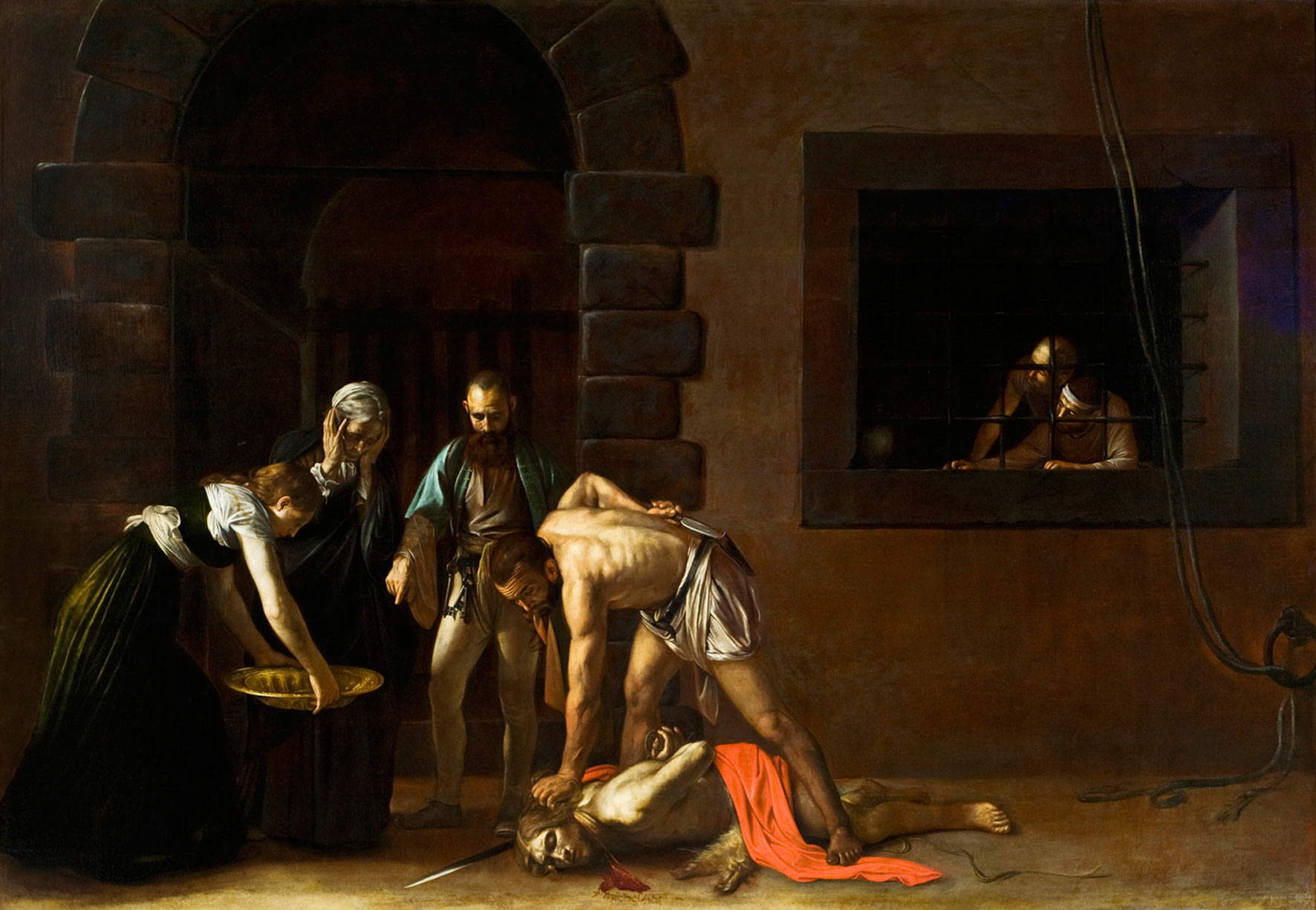 |
| Caravaggio, Beheading of the Baptist (1608; oil on canvas, 361 x 520 cm; Valletta, Co-cathedral of St. John) |
 |
| Caravaggio, David with the Head of Goliath (1609-1610; oil on canvas, 125 x 100 cm; Rome, Galleria Borghese) |
 |
| Caravaggio, Madonna of the Pilgrims (1604-1605; oil on canvas, 260 x 150 cm; Rome, Basilica of St. Augustine; photo Giuseppe Schiavinotto, Rome) |
 |
| Caravaggio, Salome with the Head of the Baptist (1607 or 1610; oil on canvas, 91.5 x 106.7 cm; London, National Gallery) |
To learn about Caravaggio’s works, it is imperative to travel to Rome. His most important works are displayed inside the oldest churches in Rome, such as the church of Sant’Agostino, which houses the Madonna dei Pellegrini (1604), or the church of San Luigi dei Francesi, which houses the triptych of the Stories of St. Matthew (1600). The church of Santa Maria del Popolo, on the other hand, houses the Crucifixion of St. Peter (1600). Also in Rome, the following works can be visited at Galleria Borghese: the Young Man with Basket of Fruit (1593), Sick Bacchus (1593), Madonna of the Palafrenieri (1605-1606), St. Jerome (1605-1606), St. John the Baptist (1610), and David with the Head of Goliath (1610).Judith and Holofernes (1957), on the other hand, is in Palazzo Barberini inside the National Galleries of Ancient Art. In the Capitoline Museums, on the other hand, it is possible to see Boy Bitten by a Lizard (1596-1597).
Of his Neapolitan period, only two works are still visible in the city and they are: Seven Works of Mercy (1606-1607) kept at the Pio Monte della Misericordia in Piazza Riaio Sforza and the second version of the Flagellation of Christ (1607-1608) painted for the church of San Domenico Maggiore and now kept at the Capodimonte Museum. In Sicily, on the other hand, his works are found at the Regional Museum of Messina, which houses the Resurrection of Lazarus (1609) and the ’Adoration of the Shepherds (1609); and at Palazzo Bellomo in Syracuse, which houses the Burial of Saint Lucy (1608). In Italy his works can also be found at theGalleriedegli Uffizi where instead Medusa (1595-1598), The Sacrifice of Isaac (1598) and Bacchus (1595) can be seen. In Cremona, the Museo Civico “Ala Ponzone” preserves San Francesco . Caravaggio’s only work in Milan, his hometown, is the Basket of Fruit, kept at the Pinacoteca Ambrosiana. In Genoa, at the Palazzo Bianco Museum, an Ecce Homo is preserved that is much debated and by several scholars not recognized as a painting by Caravaggio.
Caravaggio’s works are also exhibited in some of the major international museums including the Louvre Museum in Paris where you can find the work Good Fortune of 1596-1597, the Prado Museum in Madrid which houses the painting David and Goliath (1597-1598). Finally, if traveling to Malta, the painter’s two Maltese masterpieces in Valletta are not to be missed: the St. Jerome Writing and the Beheading of the Baptist.
 |
| Caravaggio, life, works, style and novelties of the great Michelangelo Merisi |
Warning: the translation into English of the original Italian article was created using automatic tools. We undertake to review all articles, but we do not guarantee the total absence of inaccuracies in the translation due to the program. You can find the original by clicking on the ITA button. If you find any mistake,please contact us.